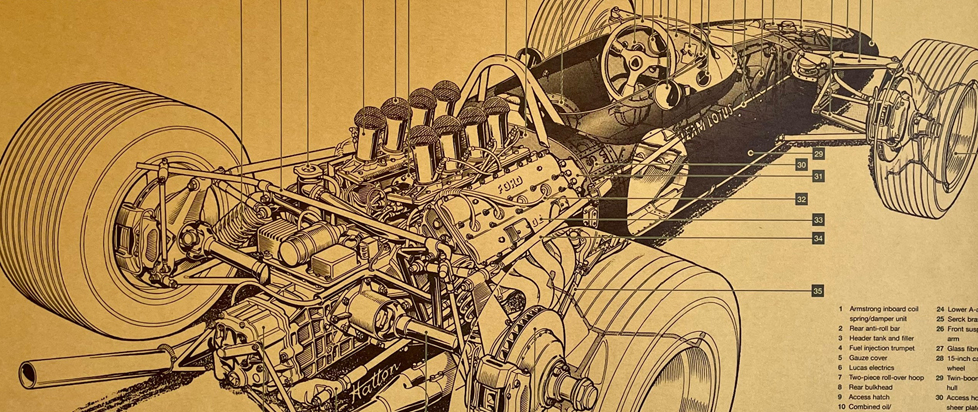
How to Build a Racecar

This column is a reprint from Unwinnable Monthly #177. If you like what you see, grab the magazine for less than ten dollars, or subscribe and get all future magazines for half price.
———
Architecture and games.
———
Something that I’ve been thinking about a lot recently is the connection between architecture and the various forms of engineering. The similarities between a skyscraper and a racecar might not be immediately apparent, but the overall approach in terms of design and construction is largely identical, at least in my opinion. They both consist of internal and external components arranged in such a way as to be conducive to human habitation, preferably to the maximum degree possible. They also have to perform a particularly demanding function. When it comes to racecars, this would of course be some combination of speed and maneuverability.
The highest performance racecars in the world are found in Formula 1. These are designed to reach speeds of up to 220 miles per hour on some of the most challenging circuits in the world. The racecars are built to strict specifications laid out by a regulator known as the Fédération Internationale de l’Automobile to ensure safety, fairness and of course competition within the sport. In terms of engineering, these racecars consist of eight different components, notably the chassis, engine, transmission, suspension, brakes, steering, tires and perhaps the most important of them all, the aerodynamics.

The chassis is quite literally the backbone of any racecar that you’ll find in Formula 1, being the structural framework upon which all of the other components are mounted. The chassis is made of a strong and lightweight material known as carbon fiber, taking the form of a monocoque, basically a structural system in which the loads are supported by the skin. The chassis must meet a series of strict safety standards determined in advance of each racing season by the FIA. They must be able to withstand high loads and impacts, most notably in the event of a crash. The chassis also plays a key role in the aerodynamics.
While there’s a case to be made for the aerodynamics, the single most important component of a racecar is definitely the engine. This of course provides the power needed to propel the vehicle down the track. The current generation of Formula 1 engines are turbocharged 1.6-liter V6 hybrid power units capable of producing more than 1,000 brake horsepower. The turbocharged aspect of the engine makes use of exhaust gasses to power a turbine which in turn powers a compressor that forces a higher volume of air into the engine. The result is a greater overall power output than would otherwise be the case. The hybrid aspect of the engine comes from the Energy Recovery System which as the name would suggest recuperates energy from the brakes and exhaust gasses to power an electric motor, something which provides an extra boost of power. The engine is tightly regulated by the FIA, strict rules on the design and construction of the engine being in place which limit the size, weight and power output. Teams are also limited to a certain number of engines for each racing season, penalties being imposed for contravention of the rules. This of course means that engines must be reliable. This particular component is the subject of constant innovation, teams always trying to extract the most performance possible while remaining within the established regulations.
The transmission is what delivers power from the engine to the wheels. The system consists of a semi-automatic gearbox featuring eight forward and one reverse gear which are operated by a pair of paddle shifters on the steering wheel, both of which are connected to an engine control unit, basically a computer. The transmission must be able to withstand the high loads and stresses imposed by the rapid cycles of acceleration and deceleration encountered hundreds of times over the course of a normal race. This component plays a key role in performance, allowing drivers to choose the most appropriate gear for a given set of conditions on track.
The component responsible for keeping the wheels in contact with the ground in addition to absorbing the various forces of the track is of course the suspension. This features a combination of wishbones, push rods, rockers and dampers. The wishbones are the main structural component of the suspension, being attached to the chassis. These hold the wheels in place while enabling them to move both up and down, apart from providing steering input. Push rods connect the wishbones to the rockers which in turn transfer the movement of the wheels to the dampers, a component which controls the movement of the wheels, preventing them from bouncing over bumps in the track. The suspension has to be light while still providing the necessary stiffness and strength to maintain proper control of the racecar. Similar to the chassis, this particular component plays a key role in the aerodynamics, being adjusted in such a way as to increase the amount of air passing over the vehicle by keeping the racecar as close as possible to the ground.

I’m sure that you already know all about them, but the brakes are primarily used to slow the vehicle down by converting friction into heat, something which can actually be turned back into power by the Energy Recovery System. These disc brakes are made out of carbon fiber, a material which is much more efficient than traditional steel brakes. The brake discs are cooled by a system of ducts to prevent overheating because they have to withstand the high temperatures and stresses of the circuit. This used to be more true before wheel covers were introduced, but you can sometimes observe the brakes glowing red at the end of a race. They also play a key role in the overall performance of the racecar on account of the fact that drivers have to brake as late as possible in order to maximize their speed through corners.
The steering unsurprisingly is all about controlling the direction of the vehicle. The system is made up of several different components including the steering rack, steering column and steering wheel. The steering rack is a mechanical device which converts the turning motion of the steering wheel into a linear motion which is used to actually turn the wheels. This tends to be located near the front of the vehicle and is connected to the wheels via tie rods. The steering column on the other hand is a shaft which is typically found inside the cockpit that connects the steering wheel to the steering rack. Similar to many other components, the steering column is designed to be as compact as possible in order to give the driver maximum control over the racecar. Steering wheels are highly complicated these days, featuring a variety of buttons, switches and knobs which drivers can use to adjust various aspects of the racecar like the angle of the rear wing, engine settings or pit lane speed limiter. The steering must be able to provide the driver with maximum feedback and precision, but similar to the brakes, this component also plays an important part in performance, drivers needing to make precise and accurate inputs to keep their speed up in the corners.
The tires are one of the most critical components of any racecar in Formula 1, being responsible for providing the car with traction and grip. They’re specially designed racing slicks with a very large contact patch made from an extremely soft rubber compound along with a couple of other materials. These actually come in three different levels of hardness with two special sets of treaded tires for wet and intermediate conditions. The tires must be able to withstand the high temperatures and stresses of racing, degradation being a serious problem throughout any given race. They also have an important role to play in terms of strategy on account of the fact that drivers must be able to choose the appropriate tire compound for the current conditions. Teams in Formula 1 are supplied by the FIA with a limited number of tires for each race and they have to make strategic decisions about when to use each type. The choice of tire compound can have a significant impact on the performance of a racecar because each compound is designed to perform best under a different set of track conditions.

The aerodynamics are the most critical component of any racecar in Formula 1, at least in my personal opinion. The bodywork including the front and rear wing, sidepods, bargeboards and diffuser are all designed to shape and direct the airflow around the vehicle in such a way as to generate a force appropriately called downforce. This pushes the car onto the track, providing extra grip and stability, especially through corners. The aerodynamics are constantly refined throughout the racing season to gain the greatest possible edge over the competition. While the front wing is mostly about directing the flow of air backwards, the rear wing is primarily responsible for generating downforce. These are both made up of several different elements including the mainplane, flaps and a pair of endplates. The sidepods which are found on either side of the vehicle house various radiators in addition to providing air intake for the engine. The bargeboards are located in front of the sidepods and are used to shape the airflow around the racecar, directing everything towards the rear wing. The diffuser at the back of the vehicle shapes the air passing under the floor, working in conjunction with the rear wing to generate downforce and improve performance.
I’ve always contended that a close connection exists between architecture and engineering. This definitely holds true for racecars, but the same could be said about many other things including airplanes, trains and boats. While I hope to cover all of these eventually, I really wanted to dive into the details of my favorite sport, Formula 1. This particular pastime isn’t particularly popular outside of Europe, so I can understand why many in America would pass on the topic, but I hope that I’ve been able to share a bit of my passion with you, providing some interesting subject matter in the process. In any case, if you’d like to learn a little more, I can always recommend picking up the latest Formula 1 game, F1 24. When you get into the finer points, you’ll pick up a lot, trust me.
———
Justin Reeve is an archaeologist specializing in architecture, urbanism and spatial theory, but he can frequently be found writing about videogames, too. You can follow him on Twitter @JustinAndyReeve.




